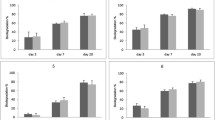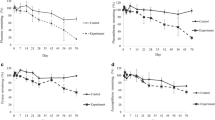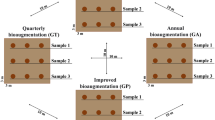Abstract
Polycyclic aromatic hydrocarbons (PAHs) are pollutants that occur in mangrove sediments. Their removal by bacteria often depends on specific characteristics as the number of benzene rings they possess and their solubility. Their removal also depends on environmental factors, such as pH, temperature, oxygen, and the ability of the endogenous or exogenous microflora to metabolize hydrocarbons. With the aim of treating mangrove sediments polluted by hydrocarbons in a biological way, a biodegradation experiment was conducted using mangrove sediments artificially contaminated with a mixture of four PAHs. The study used Rhodococcus erythropolis as an exogenous bacterial strain in order to assess the biodegradation of the PAH mixture by natural attenuation, biostimulation, bioaugmentation, and a combination of biostimulation and bioaugmentation. The results showed that the last three treatments were more efficient than natural attenuation. The biostimulation/bioaugmentation combination proved to be the most effective PAH degradation treatment.






Similar content being viewed by others
References
Arino, S., Marchal, R., & Vandecasteele, J. P. (1996). Involvement of a rhamnolipid-producing strain of Pseudomonas aeruginosa in the degradation of polycyclic aromatic hydrocarbons by a bacterial community. Journal of Applied Microbiology, 84, 769–776.
Baker, K. H. (1994). Bioremediation of surface and subsurface soils. In K. H. Baker & D. S. Herson (Eds.), Bioremediation (pp. 203–259). New York, USA: McGraw-Hill Inc.
Balba, M. T., Al-Awadhi, N., & Al-Daher, R. (1998). Bioremediation of oil-contaminated soil: microbiological methods for feasibility assessment and field evaluation. Journal Microbiology Methods, 32, 155–164.
Banerjee, D. K., Fedorak, P. M., Hashimoto, A., Masliyah, J. H., Pickard, M. A., & Gray, M. R. (1995). Monitoring the biological treatment of anthracene-contaminated soil in a rotating-drum bioreactor. Applied Microbiology and Biotechnology, 43, 521–528.
Bell, K. S., Philp, J. C., Aw, D. W. J., & Christofi, N. (1998). The genus Rhodococcus. Journal Applied Microbiology, 85, 195–210.
Brito, E. M. S., Guyoneaud, R., Goñi-Urriza, M., Ranchou-Peyruse, A., Verbaere, A., Crapez, M. A., Wasserman, J. C., & Duran, R. (2006). Characterization of hydrocarbonoclastic bacterial communities from mangrove sediments in Guanabara Bay, Brazil. Research in Microbiology, 157(8), 752–762.
Burd, G., & Ward, O. P. (1996). Involvement of a surface-active high molecular weight factor in degradation of polycyclic aromatic hydrocarbons by Pseudomonas marginalis. Canadian Journal of Microbiology, 42, 791–797.
Burns, K. A., Codi, S., Swannell, R. J. P., & Duke, N. C. (1999). Assessing the petroleum hydrocarbon potential of endogenous tropical marine wetland microorganisms: flask experiments. Mangroves and Salt Marshes, 3, 67–83.
Cai, Q. Y., Mo, C. H., Wu, Q. T., Wang, B. G., & Zhu, X. Z. (2002). Effect of municipal sludges and chemical fertiluers on the content of polycyclic aromatic hydrocarbons (PAHs) in paddy soil grown Ipomoea aquatica Fossk. Acta Pedologica Sinica (in Chinese), 39(6), 887–891.
Cerniglia, C. E. (1993). Biodegradation of polycyclic aromatic hydrocarbons. Current Opinion Biotechnology, 4, 331–338.
Cerniglia, C. E. (1992). Biodegradation of polycyclic aromatic hydrocarbons. Biodegradation, 3, 351–368.
Chen, J., Wong, M. H., Wong, Y. S., & Tam, N. F. Y. (2008). Multi-factors on biodegradation kinetics of polycyclic aromatic hydrocarbons (PAHs) by Sphingomonas sp. a bacterial strain isolated from mangrove sediment. Marine Pollution Bulletin, 57, 695–702.
de Carvalho, C. C. C. R. (2010). Adaptation of Rhodococcus to organic solvents. In H. M. Alvarez (Ed.), Biology of Rhodococcus (pp. 109–131). Berlin Heidelberg: Springer.
de Carvalho, C. C. C. R. (2012). Adaptation of Rhodococcus erythropolis cells for growth and bioremediation under extreme conditions. Resources Microbiology, 163, 125–136.
de Carvalho, C. C. C. R., Marques, M. P. C., Hachicho, N., & Heipieper, H. J. (2014). Rapid adaptation of Rhodococcus erythropolis cells to salt stress by synthesizing polyunsaturated fatty acids. Applied Microbiology Biotechnology, 98, 5599–5606.
Deziel, E., Paquette, G., & Villemur, R. (1996). Biosurfactant production by a soil Pseudomonas strain growing on polycyclic aromatic hydrocarbons. Applied Environmental Microbiology, 62, 1908–1912.
Dowty, R. A., Shaffer, G. P., Hester, M. W., Childers, G. W., Campo, F. M., & Greene, M. C. (2001). Phytoremediation of small-scale oil spills in fresh marsh environments: a mesocosm simulation. Marine Environmental Research, 52, 195–211.
Erickson, D. C., Loehr, R. C., & Neuhauser, E. F. (1993). PAH loss during bioremediation of manufactured gas plant site soil. Water Research, 27, 911–919.
Espinosa, E., Martinez, M. E., Torres, E. F., & Rojas, M. G. (2005). Improvement of the hydrocarbon phytoremediation rate by Cyperus laxus Lam. inoculated with a microbial consortium in a model system. Chemosphere, 59, 405–413.
Eun-Hee, L., Kang, L. K., & Cho, K.-S. (2011). Bioremediation of diesel-contaminated soils by natural attenuation, biostimulation and bioaugmentation employing Rhodococcus sp. EH831. Korean Journal of Microbiology Biotechnology, 39(1), 86–92.
Fan, C. Y., & Krishnamurthy, M. (1995). Enzymes for enhancing bioremediation of petroleum-contaminated soils: a brief review. Air Waste Management Association, 45, 453–460.
Forsyth, J. V., Tsao, Y. M., & Bleam, R. D. (1995). Bioremediation: when is augmentation needed. In R. E. Hinchee, J. Fredrickson, & B. C. Alleman (Eds.), Bioaugmentation for Site Remediation (pp. 1–14). Columbus: Battelle Press.
Gardner, W. S., Lee, R. F., Tenore, K. R., & Smith, L. W. (1979). Degradation of selected polycyclic aromatic hydrocarbons in coastal sediments: importance of microbes and polychaete worms. Water, Air, and Soil Pollution, 11, 339–347.
Haritash, A. K., & Kaushik, C. P. (2009). Biodegradation aspects of polycyclic hydrocarbons (PAHs): a review. Journal of Hazardous Materials, 169, 1–15.
Herbs, S. E., & Schwall, L. R. (1978). Microbial transformation of polycyclic aromatic hydrocarbons in pristine and petroleum-contaminated sediments. Applied Environmental Microbiology, 35, 306–316.
Hughes, J. B., Beckles, D. M., Chandra, S. D., & Ward, C. H. (1997). Utilization of bioremediation processes for the treatment of PAH-contaminated sediments. Journal of Industrial Microbiology and Biotechnology, 18, 152–160.
Iwamoto, T., & Nasu, M. (2001). Review: current bioremediation practice and perspective. Journal of Bioscience and Bioengineering, 92, 1–8.
Jia, L. Q., Qu, Z. Q., & Quyang, Z. Y. (2005). Ecological behavior of linear alkylbenzene sulfonate (LAS) in soil-plant systems. Pedosphere, 15(2), 216–224.
Johnsen, A. R., Wick, L. Y., & Harms, H. (2005). Principles of microbial PAH-degradation in soil. Environmental Pollution, 133, 71–84.
Joner, E. J., Corgie, S., Amellal, N., & Leyval, C. (2005). Nutritional constraints to PAH degradation in a rhizosphere model. Soil Biology Biochemistry, 34, 859–864.
Juhasz, A. L., & Naidu, R. (2000). Bioremediation of high molecular weight polycyclic aromatic hydrocarbons: a review of the microbial degradation of benzo [a] pyrene. International Biodeterioration & Biodegradation, 45, 57–88.
Kastner, M., & Mahro, B. (1996). Microbial degradation of polycyclic aromatic hydrocarbons in soils affected by the organic matrix of compost. Applied Microbiology and Biotechnology, 44, 668–675.
Ke, L., Wang, W. Q., Wong, T. W. Y., Wong, Y. S., & Tam, N. F. Y. (2003). Removal of pyrene from contaminated sediments by mangrove microcosms. Chemosphere, 51, 25–34.
Kelley, I., Freeman, J. P., Evans, F. E., & Cerniglia, C. E. (1993). Identification of metabolites from the degradation of fluoranthene by Mycobacterium sp. Strain PYR-1. Applied Environmental Microbiology, 59, 800–806.
Kinney, P. J., Button, D. K., & Schell, D. M. (1969). Kinetics of dissipation and biodegradation of crude oil in Alaska’s Cook Inlet. In Proceedings of 1969 Joint Conference on Prevention and Control of Oil Spills (pp. 333–340). Washington, D.C: American Petroleum Institute.
Kuyukina, M. S., & Ivshina, I. B. (2010). Rhodococcus biosurfactants: biosynthesis, properties, and potential applications. In H. M. Alvarez (Ed.), Biology of Rhodococcus (pp. 291–313). Berlin Heidelberg: Springer.
Kuyukina, M. S., Ivshina, I. B., Makarov, S. O., Litvinenko, L. V., Cunningham, C. J., & Philp, J. C. (2005). Effect of biosurfactants on crude oil desorption and mobilization in a soil system. Environmental International, 31, 155–161.
Lang, S., & Philp, J. C. (1998). Surface-active lipids in rhodococci. Antonie van Leeuwenhoek, 74, 59–70.
Larkin, M. J., Kulakov, L. A., & Allen, C. C. R. (2010a). Rhodococcus. In K. N. Timmis (Ed.), Handbook of Hydrocarbon and Lipid Microbiology (pp. 1839–1852). Heidelberg: Springer-Verlag.
Larkin, M. J., Kulakov, L. A., & Allen, C. C. R. (2010b). Rhodococcus: genetics and functional genomics. In K. N. Timmis (Ed.), Handbook of Hydrocarbon and Lipid Microbiology (pp. 1345–1353). Heidelberg: Springer-Verlag.
Larkin, M. J., Kulakov, L. A., & Allen, C. C. R. (2005). Biodegradation and Rhodococcus – masters of catabolic versatility. Environmental. Biotechnology, 16, 282–290.
Lu, H., Zhang, Y., Liu, B., Liu, J., Ye, J., & Yan, C. (2011). Rhizodegradation gradients of phenanthrene and pyrene in sediment of mangrove (Kandelia candel (L.) Druce). Journal of Hazardous Material, 196, 263–269.
Luan, T. G., Yu, K. S. H., Zhong, Y., Zhou, H. W., Lan, C. Y., & Tam, N. F. Y. (2006). Study of metabolites from the degradation of polycyclic aromatic hydrocarbons (PAHs) by bacterial consortium enriched from mangrove sediments. Chemosphere, 65, 2289–2296.
Marini, M., & Frapiccini, E. (2013). Persistence of polycyclic aromatic hydrocarbons in sediments in the deeper area of the Northern Adriatic Sea (Mediterranean Sea). Chemosphere, 90, 1839–1846.
Martinkova, L., Uhnakova, B., Patek, M., Nesvera, J., & Kren, V. (2009). Biodegradation potential of the genus Rhodococcus. Environmental International, 35, 162–177.
Masy, T., Demaneche, S., Tromme, O., Thonart, P., Jacques, P., Hiligsmann, S., & Vogel, T. M. (2016). Hydrocarbon biostimulation and bioaugmentation in organic carbon and clay-rich soils. Soil Biology & Biochemistry, 99, 66–74.
Mills, M. A., Bonner, J. S., McDonald, T. J., Page, C. A., & Autenrieth, R. L. (2003). Intrinsic bioremediation of a petroleum-impacted wetland. Marine Pollution Bulletin, 46, 887–899.
Mueller, J. G., Lantz, S. E., Blattmann, B. O., & Chapman, P. J. (1991). Bench-scale evaluation of alternative biological treatment process for the remediation of pentachlorophenol and creosote contaminated materials: solid phase bioremediation. Environmental Science and Technology, 25, 1045–1055.
Moreira, I. T. A., Oliveira, O. M. C., Triguis, J. A., Dos Santos, A. M. P., Queiroz, A. F. S., Martins, C. M. S., Silva, C. S., & Jesus, R. S. (2011). Phytoremediation using Rhizophora mangle L. in mangrove sediments contaminated by persistent total petroleum hydrocarbons (TPH’s). Microchemistry Journal, 29, 376–382.
Neff, J. M. (1979). Polycyclic aromatic hydrocarbons in the aquatic environment: sources, fate and biological effects. Essex, England: Applied Science Publishers, Ltd.
Park, K. S., Sims, R. C., & Dupont, R. (1990). Transformations of PAHs in soil systems. Journal Environmental Engineering, 116, 632–640.
Puri, R. K., Ye, Q. P., Kapila, S., Lower, W. R., & Puri, V. (1997). Plant uptake and metabolism of polychlorinated biphenyls PCBs. In W. Wang, J. W. Gorsuch, & J. S. Hughes (Eds.), Plants for Environmental Studies (pp. 482–513). New York: CRC Press LLC.
Ramsay, M. A., Swannell, R. P. J., Shipton, W. A., Duke, N. C., & Hill, R. T. (2000). Effect of bioremediation community in oiled mangrove sediments. Marine Pollution Bulletin, 41, 413–419.
Riser-Roberts, E. (1998). Remediation of petroleum contaminated soils: biological, physical, and chemical processes (pp. 5–313). Boca Raton: Lewis Publishers.
Samanta, S. K., Singh, O. V., & Jain, R. K. (2002). Polycyclic aromatic hydrocarbons: environmental pollution and bioremediation. Trends Biotechnology, 20, 243–248.
Sims, R. C., & Overcash, M. R. (1983). Fate of polynuclear aromatic compounds (PNAs) in soil-plant systems. Residue Review, 1, 2–68.
Song, H. G., Wang, X., & Bartha, R. (1990). Bioremediation potential of terrestrial fuel spills. Applied Environmental Microbiology, 56, 652–656.
Tam, N. F. Y., Guo, C. L., Yau, W., & Wong, Y. S. (2002). Preliminary study on biodegradation of phenanthrene by bacteria isolated from mangrove sediments in Hong Kong. Marine Pollution Bulletin, 45, 316–324.
Tam, N. F. Y., & Wong, Y. S. (2008). Effectiveness of bacterial inoculum and mangrove plants on remediation of sediment contaminated with polycyclic aromatic hydrocarbons. Marine Pollution Bulletin, 57, 716–726.
Tian, Y., Liu, H. J., Zheng, T. L., Kwon, K. K., Kim, S. J., & Yan, C. L. (2008). PAHs contamination and bacterial communities in mangrove surface sediments of the Jiulong River Estuary. China Marine Pollution Bulletin, 57, 707–715.
Trzesicka-Mlynarz, D., & Ward, O. P. (1995). Degradation of polycyclic aromatic hydrocarbons (PAHs) by a mixed culture and its components pure cultures, obtained from PAH-contaminated soil. Canadian Journal of Microbiology, 41, 470–476.
Uthe, J. F. (1991). Polycyclic aromatic hydrocarbons in the environment. Canadian Chemistry News, 43(7), 25–27.
Vogel, T. M. (1996). Bioaugmentation as a soil bioremediation approach. Current. Opinion and Biotechnology, 7, 311–316.
Walker, J. D., & Colwell, R. R. (1975). Degradation of hydrocarbons and mixed hydrocarbon substrate by microorganisms from Chesapeake Bay. Progress Water Technology, 7, 83–91.
Wannoussa, W., Masy, T., Lambert, S. D., Heinrichs, B., Tasseroul, L., Al-Ahmad, A., Weekers, F., Thonart, P., & Hiligsmann, S. (2015). Effect of iron nanoparticles synthesized by a sol–gel process on Rhodococcus erythropolis T902.1 for biphenyl degradation. Journal of Water Resource and Protection, 7, 264–277.
Weekers, F., Jacques, P., Springael, D., Mergeay, M., Diels, L., & Thonart, P. (1999). Improving the catabolic functions of desiccation-tolerant soil bacteria. In B. H. Davison & M. Finkelstein (Eds.), Twentieth Symposium on Biotechnology for Fuels and Chemicals (pp. 251–266). Gatlinburg, Tennesee: Humana Press.
Whyte, L. G., Slagman, S. J., Pietrantonio, F., Bourbonni_ere, L., Koval, S. F., Lawrence, J. R., Inniss, W. E., & Greer, C. W. (1999). Physiological adaptations involved in alkane assimilation at a low temperature by Rhodococcus sp. strain Q15. Applied Environmental Microbiology, 65, 2961–2968.
Wild, S. R., Berrow, M. L., & Jones, K. C. (1991). The persistence of polynuclear aromatic hydrocarbons (PAHs) in sewage sludge-amended agricultural soils. Environmental Pollution, 72, 141–57.
Yan, J., Cheng, S. P., Zhang, X. X., Shi, L., & Zhu, J. (2004). Effect of four metals on the degradation of purified terephthalic acid wastewater by Phanaerochaete chrysosporium and strain Fhhh. Bulletin of Environmental Contamination Toxicology, 72, 387–393.
Yu, K. S. H., Wong, A. H. Y., Yau, K. W. Y., Wong, Y. S., & Tam, N. F. Y. (2005). Natural attenuation, biostimulation and bioaugmentation on biodegradation of polycyclic aromatic hydrocarbons (PAHs) in mangrove sediments. Marine Pollution Bulletin, 51, 1071–1077.
Zhang, X. X., Cheng, S. P., Zhu, C. J., & Sun, S. L. (2006). Microbial PAH-degradation in soil: degradation pathways and contributing factors. Pedosphere, 16(5), 555–565.
Zhou, Q. X., & Hua, T. (2004). Bioremediation: a review of applications and problems to be resolved. Progress Natural Science, 14(11), 937–944.
Author information
Authors and Affiliations
Corresponding author
Rights and permissions
About this article
Cite this article
Lang, F.S., Destain, J., Delvigne, F. et al. Biodegradation of Polycyclic Aromatic Hydrocarbons in Mangrove Sediments Under Different Strategies: Natural Attenuation, Biostimulation, and Bioaugmentation with Rhodococcus erythropolis T902.1. Water Air Soil Pollut 227, 297 (2016). https://doi.org/10.1007/s11270-016-2999-4
Received:
Accepted:
Published:
DOI: https://doi.org/10.1007/s11270-016-2999-4




